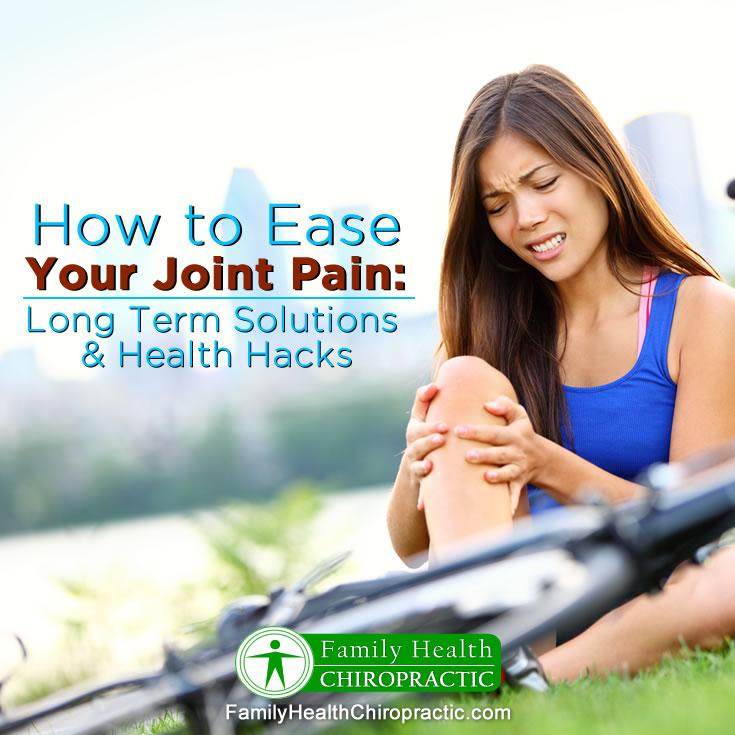Joints form the connections between the 206 bones in the human body. They are a crucial part of human movement. Without them, we’d be unable to move.
Joint pain is a frustrating and oftentimes debilitating symptom with a wide range of underlying causes. Joint pain can make it difficult for us to move, imposing a major distraction in our lives, and can even be downright debilitating.
Pain in your joints is usually accompanied by other unpleasant symptoms including joint redness, swelling, tenderness, warmth, limping, joint locking, stiff, weakness and/or a limited range of motion in the joint.
Joint pain is typically caused by the following:
- Injury to the ligaments, tendons, bones, cartilage or bursae (the fluid-filled sac in your joints that provides a cushion between our bones, tendons and/or muscles). Examples include: rotator cuff (shoulder) tear, sprained ankle, runners knee and bursitis.
- Joint inflammation due to an autoimmune condition. Examples include rheumatoid arthritis, osteoarthritis, lupus, and psoriatic arthritis.
- Bacteria or fungi can enter your body through your skin, eyes, ears, mouth, nose and mucous membranes and cause joint pain throughout your body. Examples include the bacteria that causes the following diseases: staphylococcus (staph) infections, strep throat, pneumonia, gonorrhea, tuberculosis, and Lyme disease.
In rare instances, cancer can also be the cause of joint pain.
Now that you know the primary causes of joint pain, let's learn how to make your joint pain disappear.
Long Term Solutions
Remember the three main causes of joint pain are injury, inflammation and infection. Our long term solutions for joint pain will focus on preventing and alleviating these underlying causes. First and foremost: Injury Prevention!
Long Term Joint Pain Solution #1: Learn How to Move Your Body
Learning how to move your body is your surest bet for preventing joint pain caused by injury to your ligaments, tendons, bones, cartilage or bursae. Here a few tips to get you started:
- Improve body awareness and posture in everything you do. If you're a patient of mine, you know that I begin our relationship with how to have good posture. Posture is just a fancy word for position, but your posture is what ultimately determines how healthy your ligaments, tendons, cartilage and bones will age. Do everything you can to improve your position throughout the day.
- Regularly check in with your body by practicing full body stretching. Take a yoga, pilates or a swimming class that incorporates stretching. Make a daily habit of stretching at home, preferably in a quiet, soothing environment and especially before and after any strenuous physical activity. If you have had previous injuries, target those areas because they will be your weakest link. Be sure to stretch supporting muscle groups as well. For example, if you’ve had an injury to your back, your neck and hip regions will have compensated to provide support to the injured area.
- Practice mindful, functional strength training tailored to your current capabilities. Movements like squats, deadlifts, and overhead presses executed properly with a full range of motion can go a long way to preventing joint injury. In fact, loading your joints will demonstrate your body's current vulnerabilities and give you key insight on what body parts you should be improving. Exercise doesn't hurt you- bad positioning and unhealthy joints do.
- Practice joint mobility exercises. Joint mobility exercises will include regular foam rolling, lacrosse balls or trigger points balls, banded/flossing exercises and anything that takes your joints beyond a comfortable range of motion or movement.
Long Term Joint Pain Solution #2: Identify Potential Causes
If you currently experience joint pain and it’s not due to injury, you should try to identify potential causes of infection or inflammation. Some tips include:
- Identify autoimmune reactions. Symptoms to look for include any type of unwarranted itchiness, flushed face, neck and chest, nausea or lightheadedness within an hour of eating or drinking. If you experience any of the following symptoms, you should contact a functional medicine doctor to help you identify a potential autoimmune condition:
- Tingling hands and feet
- Numb lips nose and tongue
- Swelling, hives and swollen ankles
- Dry eyes and mouth
- Digestive difficulties
- Impaired Immunity
- Low energy, fatigue and generalized stiffness.
- Identify any hidden infections. Symptoms to look for include bad breath, sinus issues like a stuffy or runny nose, malaise, hot or cold flashes and circulation problems. Underlying infections can include candida or yeast infections, staph infections, strep throat, pneumonia, gonorrhea, tuberculosis, and Lyme disease. Your functional medicine doctor can help you identify these and other underlying infections that could cause joint pain.
- Identify food sensitivities. Look for the same symptoms we talked about for identifying autoimmune reactions. Headaches, insomnia, mood swings and digestive issues can also point to a food sensitivity. Try an elimination diet to identify the foods you’re sensitive to. Another trick is to indulge in foods that you think you may be sensitive to and watch for food sensitivity symptoms, especially within the first hour after eating or drinking. One of the most common food sensitivities I find in people with joint pain is gluten intolerance.
Long Term Join Pain Solution #3: Reduce Inflammation
Reducing your body’s overall inflammation can help you mitigate joint pain. Try the following techniques:
- Modify your diet. Increase your consumption of healthy fats like coconut oil, avocados, nuts, eggs, grass-fed butter and meat. Avoid inflammatory foods and beverages like grains, legumes, sugar, seed oils and alcohol.
- Avoid humid environments. Humidity can exacerbate whole-body inflammation. Short of moving to a drier climate, you can try a dehumidifier for your home.
- Decrease your stress. Cut out unnecessary obligations and take steps to simplify your life. Avoid multi-tasking and take time for yourself every day. Try meditation or shut off your electronics and immerse in yourself in a tranquil environment like a library or park. Make sure you get enough sleep.
- Increase micronutrients and trace minerals. Use natural salts to flavor your food, consume unfiltered juices and eat the skins of fruits and vegetables, especially root vegetables, and take a multivitamin every day. In general, switch to unprocessed foods since, compared to processed foods, they naturally contain high nutrient and mineral levels.
Long Term Joint Pain Solution #4: Address Nutrient Deficiencies
Nutrient deficiencies can cause a whole host of health problems that contribute to inflammation and joint pain. If you’re puzzled on what you might be deficient in, consider a test like the SpectraCell Micronutrient test. This cutting edge method, provides an exact, detailed and comprehensive nutritional analysis. The test assesses your micronutrient deficiencies at the cellular level by determining how well your body absorbs and utilizes a number of minerals, vitamins, fatty acids, antioxidants and metabolites. This affects how well and how quickly your body rebuilds and repairs itself.
Contact us to learn how to boost your individual micronutrient levels.
Joint Pain Health Hacks
There are a number of short term solutions that can help you manage your joint pain until you can get to a functional doctor and find the underlying cause.
Joint Pain Health Hack #1: Supplement with Gelatin and Collagen
Gelatin and collagen are the building blocks of your body’s joints. If have a joint injury, your body will need extra gelatin and collagen to repair itself. You can try supplementing with gelatin and collagen products like powders, capsules and condensed liquids. You can also supplement the old-fashioned way by preparing your own bone broths (preferably with grass-fed or wild caught meat and fish) and consuming a cup or two per day.
Joint Pain Health Hack #2: Increase Magnesium, Turmeric and trace Minerals
Magnesium is crucial for your body in its ability to transport other necessary nutrients for optimal joint healing. Try a chelated magnesium supplement or find it in foods like leafy greens, pumpkin seeds, kefir, probiotic dairy, avocados, figs, banana, almonds and even dark chocolate.
Joint Pain Health Hack #3: Soak in Epsom Salts
Prepare an Epsom Salt bath and immerse your body for at least a half an hour, once a week. This is another method to increase your magnesium intake AND reduce stress simultaneously so you can ease your joint pain. The warmer the water temperature, the more bioavailable the magnesium is for your body to absorb. This solution is irresistible in winter months.
Joint Pain Health Hack #4: Elevation and Inversion
Elevate joints experiencing pain above the heart multiple times a day, for at least ten minutes. This transports the accumulated fluid in your swollen joints back to your vital organs where it can be processed and detoxified. It also reduces stress on your joints and is simple way to reduce your joint pain. A great investment for chronic joint pain is an inversion table. The inversion table allows gravity to alleviate built-up fluid and pressure in your joints.
Joint Pain Health Hack #5: Aerobic Exercise
One of the keys to alleviating joint pain, is mild, daily aerobic exercise. This gets your heart pumping which circulates excess fluid away from your swollen joints. Try walking, swimming, biking, yoga, pilates, or a team sport like soccer, basketball or vollyball. Another benefit of aerobic exercise are its mood elevating effects and its ability to speed healing and take your mind off of your joint pain.
Joint pain affects most of us from time to time, whether it’s from injury, infection or inflammation. Don’t be discouraged because there’s always a natural, short term health hack that can alleviate your pain. While joint pain usually affects middle aged to elderly age groups, everyone can benefit from the long term tactics I mentioned above. Following such a plan can help you prevent future joint issues. Choose solutions wisely and choose solutions that fit well into your lifestyle to ensure consistency.
Did this information help you in any way in understanding Joint Pain?
What are the specific treatments you've tried for your joint pain?
Share your opinion in the comments or email me!
If You Like What You Read, Click Here For Weekly Updates




